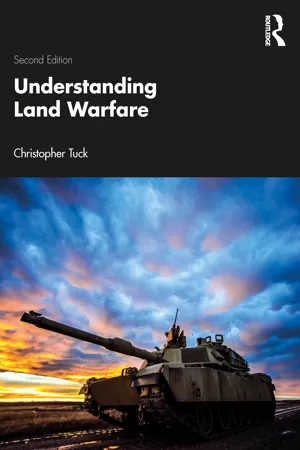We focus first on examining what it is that is distinctive about land warfare. The effective prosecution of land warfare rests in part on understanding that it cannot be approached in exactly the same way as war in the other domains. The root of the differences lies in the nature of land itself. Land embodies attributes that shape the prosecution of warfare upon it. These attributes are what make land warfare different from war on sea or in the air, and they shape the nature of land forces (see Box 1.2). Some of these attributes are, in a quite literal sense, easy to see; but others are less obvious. In particular, it is important to consider the political significance of the land domain; its variability; its opacity; its mutability; and the pervasive friction that terrain imposes on the forces that have to fight on it.
Box 1.2: Land forces, land capabilities and land power
For convenience, this book uses terms such as ‘land forces’, ‘armies’ and ‘land capabilities’ interchangeably. Strictly speaking, however, they are different:
Land forces comprise ground-oriented military organisations including armies, marines, paramilitary forces and militias. So, whilst all armies are land forces, not all land forces are armies. Land forces will often include capabilities from the other environments: army aviation, for example.
Land capabilities are categories of tasks or abilities used typically to analyse the skills and equipment of particular land forces. These capabilities might include long-range fire, short-range air defence, protected mobility, communications and combined arms manoeuvre.
Land power is a much wider concept. Land power, like other forms of power, is an outcome: one has land power to the extent to which one can get what one wants from the application of one’s land forces and capabilities. For this reason, definitions of land power tend to embody ideas such as ‘influence’ and ‘control’. For example, the US Army defines land power as ‘the ability – by threat, force, or occupation – to gain, sustain, and exploit control over land, resources, and people’.1 The British military defines land power as ‘the ability of land forces to exert decisive control and influence on actors and the course of events’.2 Land power is contextual – the same forces may generate different amounts of land power depending upon the given circumstances. Non-land environments are also likely to have an important role in generating land power. For example, maritime capabilities may be required to transport and supply land forces, and air forces make a critical contribution to land power by providing capabilities including air defence, close air support, interdiction, air mobility and reconnaissance. Space and cyber capabilities will, for some armies, make a ubiquitous contribution to land power, given their importance in aiding communications, sensors, targeting and command and control.
Political importance
Land has enormous political significance. This is because people live on land and not on the sea, or in the air, or in space, or in the electro-magnetic spectrum. In war, belligerents are territorially defined, and so it is land that, of all the environments, has the highest symbolic and physical value.3 Control over land enables a belligerent to protect or threaten vital interests, including populations, economies and political centres. Control over land is also control over the important psychological, symbolic, cultural and ideational resources that land can provide, and which are bound up with notions such as a ‘Motherland’ or a ‘historical heartland’. Because of this, in the end, the highest order security interests of political actors tend to be associated inextricably with the control of territory (see Box 1.3). Even where the principal focus of a war is in another environment, the political objective of a war will still remain the exercise of power over an adversary that is territorially constituted. Even navies and air forces themselves rely on territorial bases for their continued functioning.
Box 1.3: The importance of land warfare
Since men live upon the land and not upon the sea, great issues between nations at war have always been decided – except in the rarest of cases – either by what your army can do against your enemy’s territory and national life, or else by the fear of what the fleet makes it possible for your army to do.
(Sir Julian Corbett, Some Principles of Maritime Strategy, 1911)4
Therefore, whether it is the surrender of France to Germany in 1940, the taking of Saigon by North Vietnam in 1975, Islamic State’s loss of their capital, Raqqa, in 2017 to the Syrian Democratic Forces, or the fall of Kabul to the Taliban in 2021, the ability to take and hold an opponent’s territory, or to threaten credibly to do so, remains a core metric of success in war.
Variability
One of the most mundane observations regarding terrain is also one of the most important militarily: it is highly variable. Land is not a consistent medium. Unlike the sea or air, land embodies great variety in geography, vegetation and population density, different combinations of which can create difficult challenges for land forces. Operations in urban areas, for example, require very different methods to those required to fight in open terrain (see Box 1.4). For example, mountains, jungles, urban areas and forests are problematic operating environments for vehicles; communication and visibility are difficult; movement is often channelled. Deserts can pose fewer problems in relation to visibility and manoeuvre, especially for tracked vehicles, but desert sand poses problems for the reliability of equipment and the stamina of personnel; navigation can also be problematic. Land’s variability is magnified by the effects of climate and weather: excessive heat, snow, rain or mud can transform the characteristics of even flat terrain, constraining manoeuvre, limiting visibility and/or depressing morale. Moreover, this diversity can be heavily concentrated: the same battlefield can exhibit widely...
